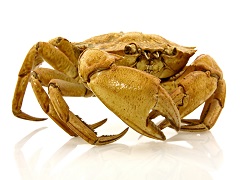Features
Using the unusable
Date: 2017-09-12 12:55:49.0
Author: Memorial University
 It is said that every creature on Earth has a purpose, though scientists and fishers alike are dubious about the usefulness of carcinus maenas.
It is said that every creature on Earth has a purpose, though scientists and fishers alike are dubious about the usefulness of carcinus maenas.
The green crab population, whose sole purpose appears to be wreaking havoc on Newfoundland and Labrador’s ocean ecosystems, currently remains unchecked by natural predators.
Invading species
The green crab, native to Europe, was inadvertently introduced to the East Coast of North America in 1990s via the bilge water of a container ship. It is small and vicious, and because of its size offers little utility in the way of cuisine.
“Green crab are invading sea area habitats where traditionally snow crab, lobster and other ground fish species are harvested,” said Dr. Don-Roger Parkinson, a professor of chemistry at Grenfell Campus.
“On this side of the ocean, green crab have no predator species to keep their populations in check. The green crab species multiplies quite quickly, is very voracious and it out competes and causes harm to many other commercially important fish species.”
Dr. Parkinson is hoping to change the “good for nothing” reputation of this vicious ravager through his research on chitin.
Chitin is a polymeric chemical and is most commonly found in insects and crustaceans with hard exoskeletons. It is a glucose-based molecule, similar to cellulose, which provides structure in plants. Chitin can be extracted by boiling shells with acid.
The research being conducted by Dr. Parkinson and his team of fourth-year environmental science students focuses on the ability of chitin to act as a biomaterial in metal extraction applications to take up and retain heavy metals from contaminated waters, making it a cheaper replacement for activated carbon in water purifiers.
“Third world communities could avail of these systems for their water quality, which in turn would reduce diseases and the costs incurred and enhance their life expectancy to their population,” he said.
Environmental and employment benefits
In addition, using chitin materials from fishery by-catch and shell wastes from the fishery would leave a cleaner footprint on the environment, he says, and could potentially increase the employment in the fishery and associated industries.
Dr. Parkinson notes there are some Newfoundland and Labrador startup companies that are beginning to investigate natural sea materials for economic enterprises. He says this research would dovetail nicely with his project’s exploration and needs.
While his research team has availed of internal grants from Grenfell Campus, they are currently putting together a proposal for seed money from the larger university and are looking for investors, backers and collaborators in this area to help advance this research.
“It is estimated that 30,000 tons of shell waste is produced from the island fishery of Newfoundland and Labrador yearly,” said Dr. Parkinson. “The focus of this research is to make chemical products and to design them, when their utility is over, to be environmentally friendly. Hence the motto ‘environmental from birth to grave.’”
About Memorial University
Established as a memorial to the Newfoundlanders who lost their lives on active service during the First and Second World Wars, Memorial University draws inspiration from these shattering sacrifices of the past as we help to build a better future for our province, our country and our world.
For further information about Memorial University, please visit the website here.
Displaying 1 keywords used to tag this article:
- Roger Vivier Ballernice Crystal Buc
